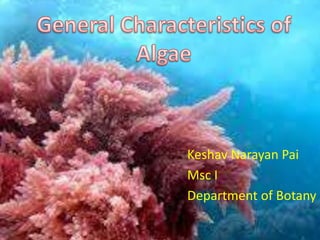
General characteristics of algae
- 1. Keshav Narayan Pai Msc I Department of Botany
- 2. They are Thallophytes which have chlorophyll as their primary photosynthetic pigment and lack a sterile covering of cells around the reproductive cells.
- 3. Habit and Habitat They may be free floating , free swimming or attached to the bottom in the shallow water. According to habitat, algaes can be classified as follows: Aquatic algae: Example:- Chlamydomonas. Terrestrial algae : Example:- Fritschiella. Aerophytes : Example:- Scytonema. Cryophytes : Example:- Scotiella. Thermophytes : Example:- Oscillatoria brevis. Algae of unusual habit : Example:- Dunaliella.
- 4. Acquatic Algae • Found from tiniest ditch to the mightiest river and ocean.
- 9. These are found free floating or freely swimming in water.
- 10. These are never attached to the substratum.
- 11. Beginning they gets attached but later they get detached.
- 12. Terrestrial Algae These are found on or beneath the soil surface. Example: Trentifolia sp.
- 13. AEROPHYTES They are adopted to the aerial life,occur on tree trunks, moist walls, flower pots, rocks..etc
- 14. Cryophytes(snow algae) Found on mountain peaks with snow.
- 15. Thermophytes Hot springs, tolerate temperature upto 85c.
- 16. Halophytic Algae They are present in water containing high percentage of salt.
- 17. Lithophytes Found on moist rocks and rocky surfaces.
- 18. Epiphytic Algae • The algaes grow on other plants. Ceplaleuros algae on Chrysophyllun leaf
- 19. Epizoic Algae These algaes are found on shells of molluscans, turtles and fins of fishes. Example: Acrosiphonia.
- 20. These are found inside the body of aquatic animals. • Example: Zoochlorella found inside the Hydra Viridis
- 21. Eg: Cephaleuros virescens causes ‘ Red rust of tea’,by which a severe damage is caused.
- 22. Many Cyanophycean members grow in symbiotic association with other plants. Association of Nostoc within thalli of Anthoceros.
- 23. Their sizes varies from 0.5microns to 700 feet( giant kelps) in length.
- 24. Thallus Organization Algae exhibit great diversity in organization of plant body. Unicellular Motile Non-motile Colonial Coenobial Filamentous Simple Branched Dendroid
- 25. They are single celled algae. They may be motile flagellated. example: Chlamydomonas. They may be non-motile coccoid. example: Chlorella
- 26. The cells are grouped in aggregations called Colonies.
- 27. It is a colony with fixed number of cells. Example:16 cells in Pandorina, 32 cells in Eudorina.
- 28. Filamentous Filamentous types are multicellular. They may be simple or unbranched. Example: ulothrix, spirogyra. They may be branched. Branching is of 2 types: True branching. Ex: Sytonema. False branching. Ex:Cladophora.
- 29. Dendroid means tree like. These appear like microscopic trees .example: Prasinocladus.
- 30. Structure of the algal cell Prokaryotic cell They are found in the members of Cyanophyta. Cell wall contains mucopeptide. DNA materials are concentrated in the centre and nuclear membrane is absent. Chloroplast, Mitochondria, Golgi bodies, Plastids and Endoplasmic reticulum is absent. Ribosomes are present. Nuclear division doesnt take place by mitosis.
- 31. Eukaryotic cell Eukaryotic cell has the structure as in typical cell of higher plants. Nucleus separated from Cytoplasm by distinct nuclear membrane. It divides by mitosis. Cytoplasm contains chloroplasts, mitochondria, golgi bodies and endoplasmic reticulum.
- 32. Algal Pigments Colour of algaes varies due to presence of definite chemical compounds called as pigments. Photosynthetic pigments in algae are of 3kinds, Chlorophyll Carotenoids Phycobilins or biliproteins.
- 33. CHLOROPHYLL Algal chlorophylls is represented by greencolour. They are fat soluble compounds. Chlorophyll a is comman in all group of algaes. Chlorophyll b, c, d and e have restricted distribution.
- 34. Carotenoids These are fat soluble yellow coloured pigments. They are sub divided into carotenes and xanthophylls. There may be 20 xanthophylls so far known. Carotenes are of 5types. α, β, γ, lycopene and ε carotene.
- 35. Phycobilins Phycobilins include red coloured Phycoerythrins and blue coloured phycocyanins. They are present in members of Cyanophyceae and Rhodophyceae.
- 36. Algal Flagella Flagella are extremely fine and hyaline emergence of the cytoplasm. Single anterior flagellum In pairs Many in number Isokont( equal in length) Heterokont(unequal in length)
- 37. Nutrition Algaes are Autotrophic. All or most of the cells of thallus normally contain chlorophyll. The cells can manufacture their own carbohydrate food from carbon dioxide and water through the agency of sunlight.
- 38. FOOD RESERVES Food accumulates in the form of polysaccharides. Those are cyanophycean starch and floridean starch(rhodophyta). Three important reserve food are laminarin, paramylin and leucosin. Mannitol is also another reserve food in red algae.
- 39. Vegetative reproduction: Fragmentation Cell division Hormogone formation. Tubers Bulbils Akinetes
- 40. By aplanospores, autospores, endospore and auxospores and cyst formation. Palmella stage occurs in Chlamydomonas .
- 41. Sexual Reproduction By fusion of two specialised cell known as sex cells or gametes. Isogamous- two identical gametes fuse to form zygotes. Heterogamous- dissimilar gametes fuse
- 42. Sexual reproduction in Chlamydomona
- 46. Beneficial Aspects of Algae Food for humans Food for invertebrates and fishes in mariculture Animal feed Soil fertilizers and conditioners in agriculture Treatment of waste water Diatomaceous earth (= diatoms) Phycocolloids (agar, carrageenan from red algae; alginates from brown algae) Drugs Model system for research
- 47. Blooms of freshwater algae Red tides and marine blooms Toxins accumulated in food chains Damage to cave paintings, frescoes, and other works of art Fouling of ships and other submerged surfaces Fouling of the shells of commercially important bivalves
- 48. No other forms of organisms are so colourful as that of algae. Various pigments can be found in the algae. They are ubiquitous and the thallus organisation contains diversity.
- 49. References O.P.Sharma .1986. Textbook of Algae, Tata Mcgraw-Hill Education:Pg.no.2-4. A.V.S.S.Sambamurty.2005. A Textbook of Algae, I.K.International Pvt.Ltd:Pg.no.3-4. http://www.algologists.yolasite.com
